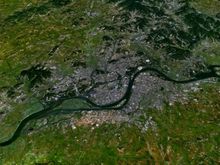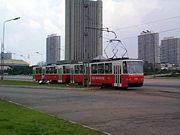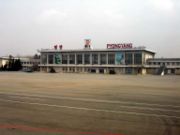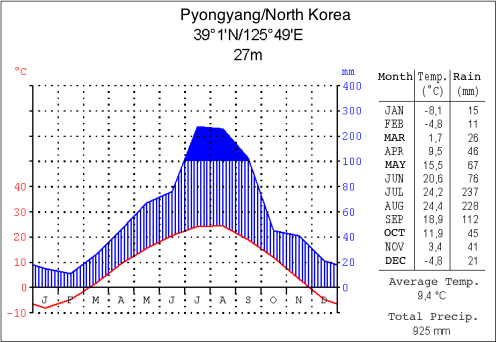Pyongyang
2008/9 Schools Wikipedia Selection. Related subjects: Geography of Asia
| P'yŏngyang Directly Governed City | ||||||||||
|---|---|---|---|---|---|---|---|---|---|---|
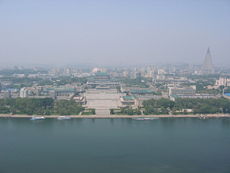 P'yŏngyang. |
||||||||||
| Korean name | ||||||||||
|
||||||||||
| Short name | ||||||||||
|
||||||||||
| Statistics | ||||||||||
|
||||||||||
| Location map | ||||||||||
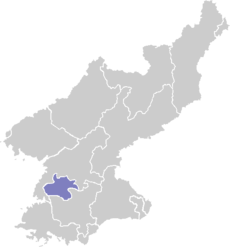 Map of North Korea highlighting the city. |
||||||||||
| Notes | ||||||||||
| Founded in 2333 BC as Wanggŏmsŏng. |
Pyongyang (IPA: /pʰjʌŋjaŋ/) is the capital and largest city of North Korea, located on the Taedong River, at . The official population of the city is not disclosed; given as 2,741,260 in 1993, it was reported as 2.5 and 3.8 million in 2002 and 2003 by Chongryon, a pro-North Korean organization in Japan.
The city was split from the South P'yŏngan province in 1946. It is administered as a Directly Governed City (Chikhalsi), on the same level as provincial governments, not a Special City (Teukbyeolsi) as Seoul is in South Korea. Some sources, mostly older and South Korean, refer to P'yŏngyang as a Special City, but it has been reported that even the South Korean government adopted the Directly Governed City terminology in 1994.
History
A large ancient village in the P'yŏngyang area called Kǔmtan-ni was excavated in 1955 by archaeologists who found prehistoric occupation from the Chǔlmun and Mumun pottery periods.
According to legend, the city was founded in 2333 BC as Wanggŏmsŏng (왕검성; 王儉城). It became a major city under Gojoseon.
In 108 BC Han Dynasty China conquered Gojoseon and the capital of the Lelang Commandery was put near Pyongyang. Lelang remained an important commercial and cultural outpost until it was destroyed by the expanding Goguryeo in 313.
Goguryeo moved its capital here in 427. Tang Dynasty China and Silla allied and defeated Goguryeo in 668. In 676, it was taken by Silla but left in the border between Silla and Balhae until the Goryeo dynasty, when the city was revived as Sŏgyŏng (서경; 西京; "Western Capital") although never actually a capital of Goryeo. It was the provincial capital of the P'yŏngan Province during the Joseon dynasty, becoming provincial capital of South P'yŏngan Province from 1896 and through the period of Japanese rule.
In 1945, Japanese rule ended and it was occupied by Soviet forces, and became the temporary capital of the Democratic People's Republic of Korea at its establishment in 1948 while it aimed to recapture its official capital at that time of Seoul. It was severely damaged in the Korean War, during which it was briefly occupied by South Korean forces. After the war, the city was quickly rebuilt with Soviet help, with many buildings built in Stalinist architecture.
Historic names
One of its many historic names is Ryugyŏng (류경; 柳京), or "capital of willows", as willow trees have always been numerous throughout the city's history, and many poems written about these willows. Even today, Pyongyang has numerous willow trees planted everywhere, and many buildings and places have "Ryugyŏng" in their names, the most notable of all being its uncompleted Ryugyŏng Hotel. Its other historic names include Kisŏng, Hwangsŏng, Rangrang, Sŏgyŏng, Sŏdo, Hogyŏng, Changan, etc. During the Japanese occupation, and in the Japanese language, it is also known as Heijō, which is simply the Japanese reading of the Chinese characters 平壌 the name Pyongyang consists of.
Landmarks
The capital has been completely redone since the Korean War (1950–1953). It is designed with wide avenues, imposing monuments, and monolithic buildings. The tallest structure in the city is the uncompleted 330-metre (1,083 ft) Ryugyŏng Hotel. This hotel has 105 floors, encloses 361,000 square metres (3,885,772 sq ft) of floor space, and was planned to be topped by seven revolving restaurants. However, construction has been stalled since the early 1990s and the building stands as an empty shell.
Some notable landmarks in the city include the Kumsusan Memorial Palace, the Arch of Triumph (heavily inspired by Paris's Arc de Triomphe but of a larger size), the reputed birthplace of Kim Il-sung at Mangyongdae Hill, Juche Tower, and two of the world's largest stadiums ( Kim Il Sung Stadium and Rungnado May Day Stadium). Pyongyang TV Tower is a minor landmark. Other visitor attractions include the Korea Central Zoo and the large golden statues of North Korea's two leaders. The Arch of Reunification has a map of a united Korea supported by two concrete Korean women dressed in traditional dress straddling the multi-laned Reunification Highway that stretches from Pyongyang to the DMZ.
Transportation
Metro system
Pyŏngyang has a two-line underground metro system which has a length of 22.5 kilometers (14 mi). The Hyoksin line serves Kwangbok, Konguk, Hwanggumbol, Konsol, Hyoksin, Jonu, Jonsung, Samhung and Rakwon station. The Chollima line serves Puhung, Yonggwang, Ponghwa, Sungni, Tongil, Kaeson, Jonu and Pulgunbyol station. There is also a 53 km (33 mi) long tram and 150 km (93 mi) trolleybus service, but tourists have heard that few locals use them due to the high and frequent hazard of electrocution. There are not as many private automobiles as in Western cities, although the state government operates a sizeable fleet of Mercedes-Benz limousines for Party bureaucrats. Many residents walk, cycle, or use the subway.
Air transportation
State-owned Air Koryo has scheduled flights from Sunan Capital International Airport to Beijing ( PEK), Shenyang ( SHE), Vladivostok ( VVO), Macau ( MFM), Bangkok ( BKK),( KHV) and ( SZX. There are occasional chartered flights to Incheon ( ICN), Yangyang County ( YNY) and several Japanese cities. Air Koryo also claims scheduled service on a few domestic routes, although the accuracy of this is not known the only domestic routes are Hamhung,Wonsan,Chongjin,Hyesan and Samjiyon. Intermittent service to Pyongyang is also provided by a few foreign carriers, most notably Chinese. In April 2008, Air China launched regular, 3-days-per-week, service between Beijing and Pyongyang.
Intercity trains
The city also has regular international train services to Beijing and Moscow. A journey to Beijing takes about 25 hours and 25 minutes ( K27 from Beijing / K28 from Pyŏngyang, on Mondays, Wednesdays, Thursdays and Saturdays); a journey to Moscow takes 6 days.
Climate
| Weather averages for Pyongyang, North Korea | |||||||||||||
|---|---|---|---|---|---|---|---|---|---|---|---|---|---|
| Month | Jan | Feb | Mar | Apr | May | Jun | Jul | Aug | Sep | Oct | Nov | Dec | Year |
| Average high °F (°C) | 29 (-1) | 35 (1) | 47 (8) | 61 (16) | 71 (21) | 78 (25) | 82 (27) | 83 (28) | 75 (23) | 63 (17) | 47 (8) | 34 (1) | 59 (15) |
| Average low °F (°C) | 14 (-10) | 19 (-7) | 30 (-1) | 41 (5) | 52 (11) | 62 (16) | 69 (20) | 69 (20) | 58 (14) | 45 (7) | 33 (0) | 20 (-6) | 43 (6) |
| Precipitation inches (cm) | 0.6 (1) | 0.5 (1) | 1.1 (2) | 1.9 (4) | 2.7 (6) | 3.1 (7) | 9.9 (25) | 9.1 (23) | 4.5 (11) | 1.7 (4) | 1.7 (4) | 0.8 (2) | 36.9 (93) |
| Source: Weatherbase Feb 2007 | |||||||||||||
Sister cities
 Kathmandu, Nepal
Kathmandu, Nepal
